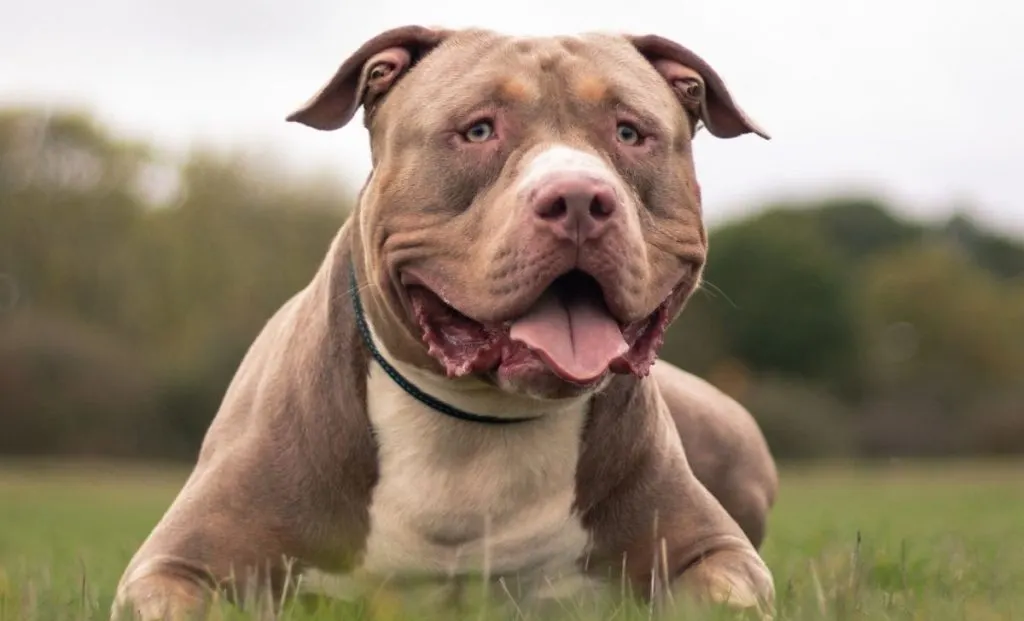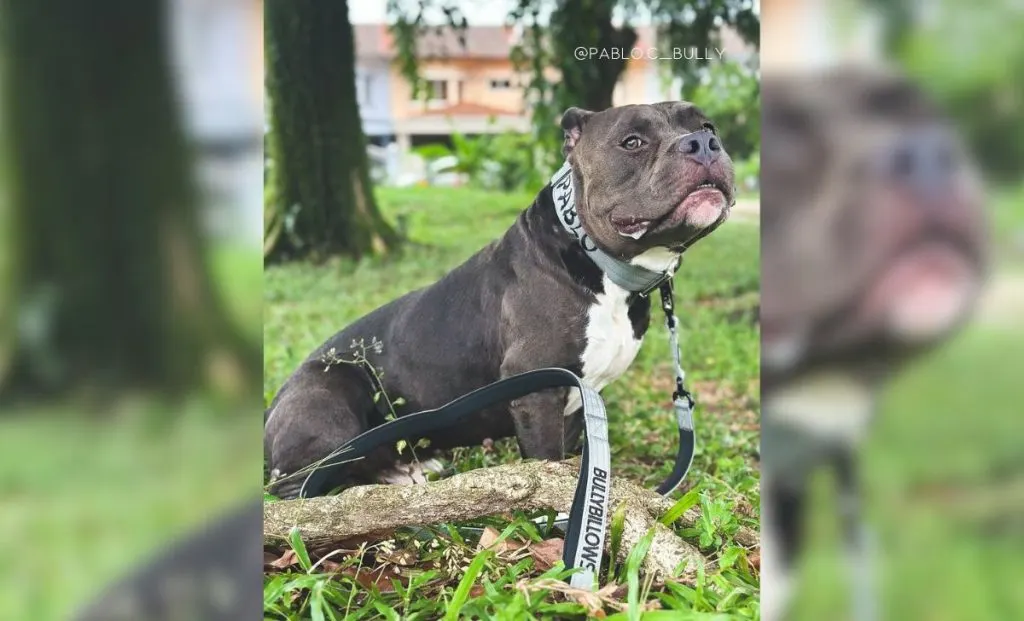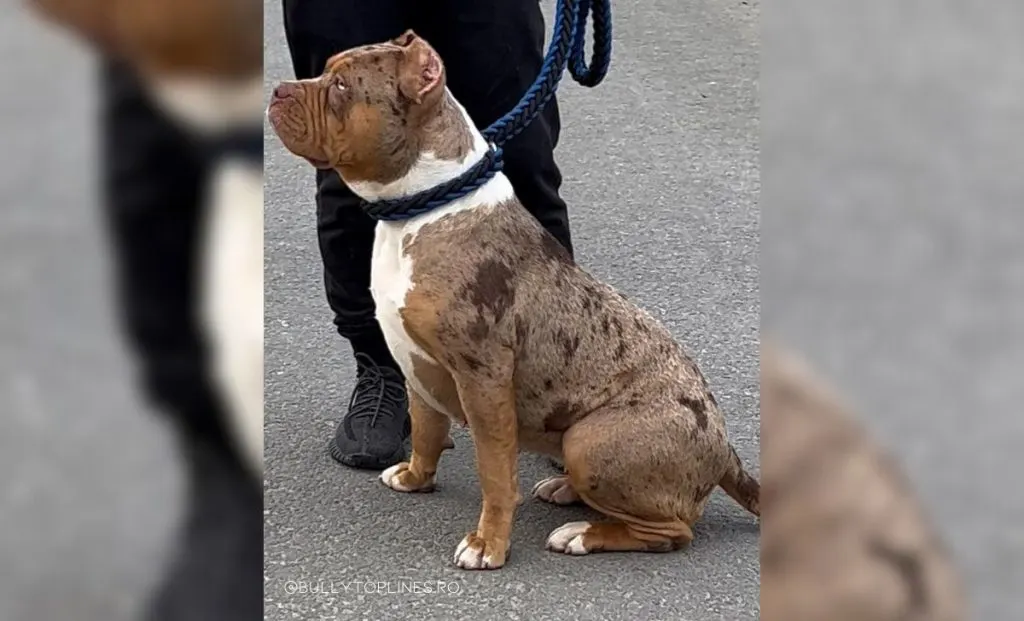So, you’ve noticed there is something wrong with your pup and now you are asking yourself ”Why is my American Bully breathing hard?”
Many paw owners face this issue, and understanding the reasons can help you take better care of your furry friend.
Let’s explore some potential causes of heavy breathing in the American Bully breed and some easy ways to help them out.
1. Brachycephalic Obstructive Airway Syndrome

The American Bully breed often has what’s called brachycephalic airway syndrome (BOAS).
This condition is well-documented in brachycephalic breeds like Bulldogs and Pugs. It involves a combination of anatomical abnormalities such as stenotic nares (narrow nostrils), an elongated soft palate, and everted laryngeal saccules (1).
These features can lead to breathing difficulties, making them breathe fast or sound labored.
Unfortunately, there is no medication to cure brachycephalic syndrome; surgery is often the only option to improve breathing.
However, it’s important to note that breeding practices are to blame for these issues, and the best preventive measure would be to change breeding standards to prioritize health over appearance.
Taking this into account, it is worth noting that certain American Bully mixes are considered healthier than purebred dogs because they inherit different head anatomical traits.
2. Heatstroke
Due to the fact American Bullies are dogs with brachycephalic syndrome, they are more prone to heatstroke due to their compromised respiratory function (2).
This occurs when your dog’s body temperature rises above the normal temperature range, leading to severe distress symptoms.
Heatstroke can cause rapid breathing and is a medical emergency.
If you notice signs of heatstroke in your American Bully, such as heavy, fast breathing, seek immediate help from an emergency vet.
3. Obesity

Obesity is a common issue in American Bullies that can significantly impact their breathing.
When dogs carry extra weight, it puts pressure on their lungs and heart, making it harder for them to breathe normally.
Both male and female American Bullies can be affected by obesity similarly.
4. Allergies
Certain everyday allergens like certain ingredients in dog food, pollen, and those pesky dust mites can really stir up trouble for your pup’s breathing and overall respiratory health.
These allergies often result in skin problems, making your Bully uncomfortable and causing them to scratch frequently.
Consult with your vet about prescribed medications to manage allergy symptoms.
Some treatment options also include regular bathing and using hypoallergenic shampoos can help soothe itchy skin.
Identify and avoid allergens that trigger your dog’s symptoms. Try to keep your home clean and use air purifiers to maintain clean air.
5. Respiratory Issues

If your American Bully is showing signs of heavy breathing, it could indicate underlying respiratory issues that need attention.
In fact, when they notice signs of labored breathing, the first thing people do is ask ”Why is my American Bully breathing so hard? Is he suffering from a specific respiratory issue?”
Let’s address some most common causes of breathing problems that are linked to the dog’s respiratory system and what signs to watch out for.
Pulmonary Contusions
Pulmonary contusions are bruises or injuries to the American Bully’s lung tissue.
This happens when a dog gets a strong blow to their chest, like from a fall or accident. This can make it hard for them to breathe because the injury affects how well their lungs can work.
Pulmonary contusions can be serious, so getting prompt help from the vet can make a big difference in your dog’s recovery.
Pulmonary Edema
Pulmonary edema happens when fluid builds up in the tiny air sacs (alveoli) of the dog’s lungs.
This accumulation makes it harder for oxygen to pass from the lungs into the bloodstream, leading to breathing difficulties.
The most common causes include heart disease, especially congestive heart failure , inhalation of toxins or chemicals and pulmonary infections.
Pulmonary edema can be life-threatening and requires prompt veterinary care.
Pulmonary Hypertension
This occurs when there is high blood pressure in the arteries of the lungs.
This condition forces the right side of the heart to work harder to pump blood through the lungs, leading to potential heart failure over time.
Respiratory Infections
Upper and lower airway conditions can affect your Bully’s respiratory system, causing a variety of breathing problems.
Sometimes, these respiratory diseases can lead to severe situations that require emergency veterinary care.
Upper Respiratory Tract Infections
Upper airway causes of rapid breathing involve the upper respiratory tract as your dog’s nose, throat, and windpipe. Just like us, dogs can catch a cold or sniffle from viruses or bacteria floating around.
Upper respiratory tract infections include kennel cough and canine influenza, which cause symptoms like coughing, sneezing, and nasal discharge.
Lower Respiratory Tract Infections
Lower respiratory tract infections (pneumonia and bronchitis) mean the bug has traveled down into the lungs, making things a bit more serious.
Aside from breathing faster, symptoms can include fever and a deep cough which isn’t just any cough. It might sound like your pup has something stuck in their chest.
Pulmonary Thromboembolism (PTE)
Pulmonary thromboembolism occurs when a blood clot forms in one part of the body, often the legs, and travels through the bloodstream until it lodges in a blood vessel in the lungs.
This blockage can severely restrict blood flow and oxygen exchange, leading to sudden and serious breathing difficulties for your American Bully dog.
Conditions like heart disease, certain cancers, and post-surgical recovery periods can increase the risk of clotting.
Dogs that are immobilized for extended periods or have experienced known trauma are also more susceptible.
If you suspect your dog may be experiencing PTE, it is crucial to seek emergency veterinary care immediately.
6. Heart Problems

Heart problems, such as congestive heart failure and heart diseases, are significant concerns for American Bully owners.
These conditions can lead to a variety of breathing difficulties, including fast breathing, labored breathing, and rapid breathing.
Congestive Heart Failure
Congestive heart failure (CHF) occurs when your Bully’s heart struggles to pump blood effectively, leading to fluid buildup in the lungs and throughout the body.
This fluid can lead to pulmonary edema, where the airways get filled with fluid, making it tough for your dog to breathe.
Heart Disease
Heart disease includes various conditions that mess with your dog’s heart function, like valve disorders and cardiomyopathy.
These issues can cause hard breathing and other breathing irregularities in American Bullies.
One study shows that CVHD, especially mitral valve disease, is the most common cardiac condition in older, small breed dogs. It often leads to heart failure if not managed properly (3).
Given that Micro and Pocket Bullies are more on the smaller side, they might be more susceptible to CVHD than other Bully sizes.
Another study explains how older dogs are more prone to various heart conditions.
Age-related changes include decreased arterial compliance and increased stiffness of the ventricles, contributing to the development of cardiovascular diseases (4).
7. Exercise Intolerance

Even though American Bullies look tough, they can sometimes struggle with exercise.
This means they might get tired quickly or find it hard to keep up during playtime, even if they are not subjected to vigorous exercise.
You might notice them panting a lot, breathing fast, or needing breaks more often than other dogs. They may need a bit more rest between adventures!
8. Anxiety And Stress
American Bullies can be sensitive souls, which sometimes leads to anxiety, stress or even aggressive behavior.
When they feel anxious, you might notice them breathing quickly, panting a lot, or acting a bit jittery.
9. Kidney Failure

When kidneys don’t work well, toxins build up in the body, affecting their lungs and making it harder to breathe.
Symptoms can include quick or difficult breathing, as well as signs such as heightened thirst and frequent urination.
10. Cushing’s Disease
Cushing’s disease, a condition where the dog’s body produces too much cortisol, can also cause heavy breathing.
This hormone imbalance affects their metabolism and can lead to symptoms such as panting, along with hair loss and a potbelly appearance.
11. Poisoning

Certain plants, like lilies, azaleas, and oleander, are toxic to dogs and can cause rapid breathing if ingested.
Certain human foods, such as chocolate, grapes, onions, and xylitol (a sweetener), are toxic to all dogs, including the sturdy Bullies, and can cause respiratory symptoms if ingested in sufficient quantities.
Poisoning can affect their breathing quickly, along with other signs like drooling, vomiting, or seizures. Get to the vet ASAP!
Is It Normal For American Bullies To Pant A Lot?
Yes, it is normal for American Bullies to pant more than some other dog breeds.Their anatomical characteristics make them prone to panting.
While some level of panting is normal and necessary, excessive or persistent panting in these dogs can sometimes indicate underlying issues.
So, if you wonder ”Why is my American Bully breathing so fast?” Remember it can stem from various factors, not just exercise or hot weather.
Remember, keeping up with regular vet consultation, a proactive approach, and giving your Bully lots of love and attention will keep them happy, healthy, and ready for all the adventures together!
References
- Riecks, T., Birchard, S., & Stephens, J. (2007). Surgical correction of brachycephalic syndrome in dogs: 62 cases (1991-2004).. Journal of the American Veterinary Medical Association, 230 9, 1324-8 . https://doi.org/10.2460/JAVMA.230.9.1324.
- Bruchim Y, Horowitz M, Aroch I. Pathophysiology of heatstroke in dogs – revisited. Temperature (Austin). 2017 Oct 9;4(4):356-370. doi: 10.1080/23328940.2017.1367457. PMID: 29435477; PMCID: PMC5800390.
- Patteson, M. (2012). Treatment of canine heart disease. In Practice, 34, 18 – 25. https://doi.org/10.1136/inp.f6017.
- Guglielmini, C. (2003). Cardiovascular Diseases in the Ageing Dog: Diagnostic and Therapeutic Problems. Veterinary Research Communications, 27, 555-560. https://doi.org/10.1023/B:VERC.0000014216.73396.f6.

Meet Iram, a devoted veterinarian, passionate dog lover, and current Ph.D. candidate at Utrecht University in the Netherlands. Seamlessly blending her roles as a vet and content writer, Iram channels her love for dogs into heartfelt narratives.
Since childhood, Iram nurtured a dream of becoming a vet, a passion that runs deep in her family. Having now fulfilled that dream, she’s eager to share her acquired knowledge. In her writing, Iram not only explores the emotional bond between humans and their canine friends but also integrates her veterinary expertise, offering readers a holistic understanding of their beloved pets.
